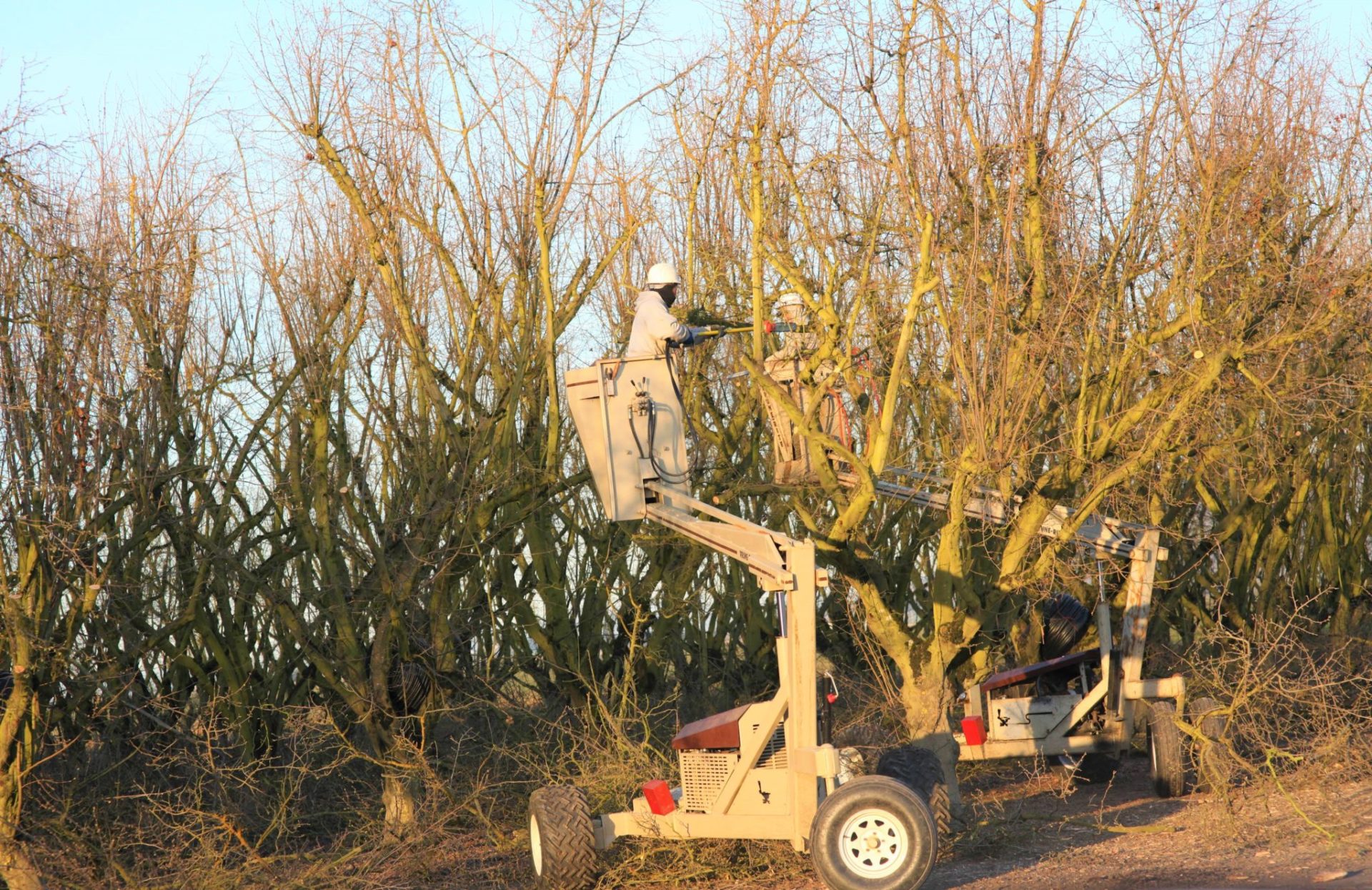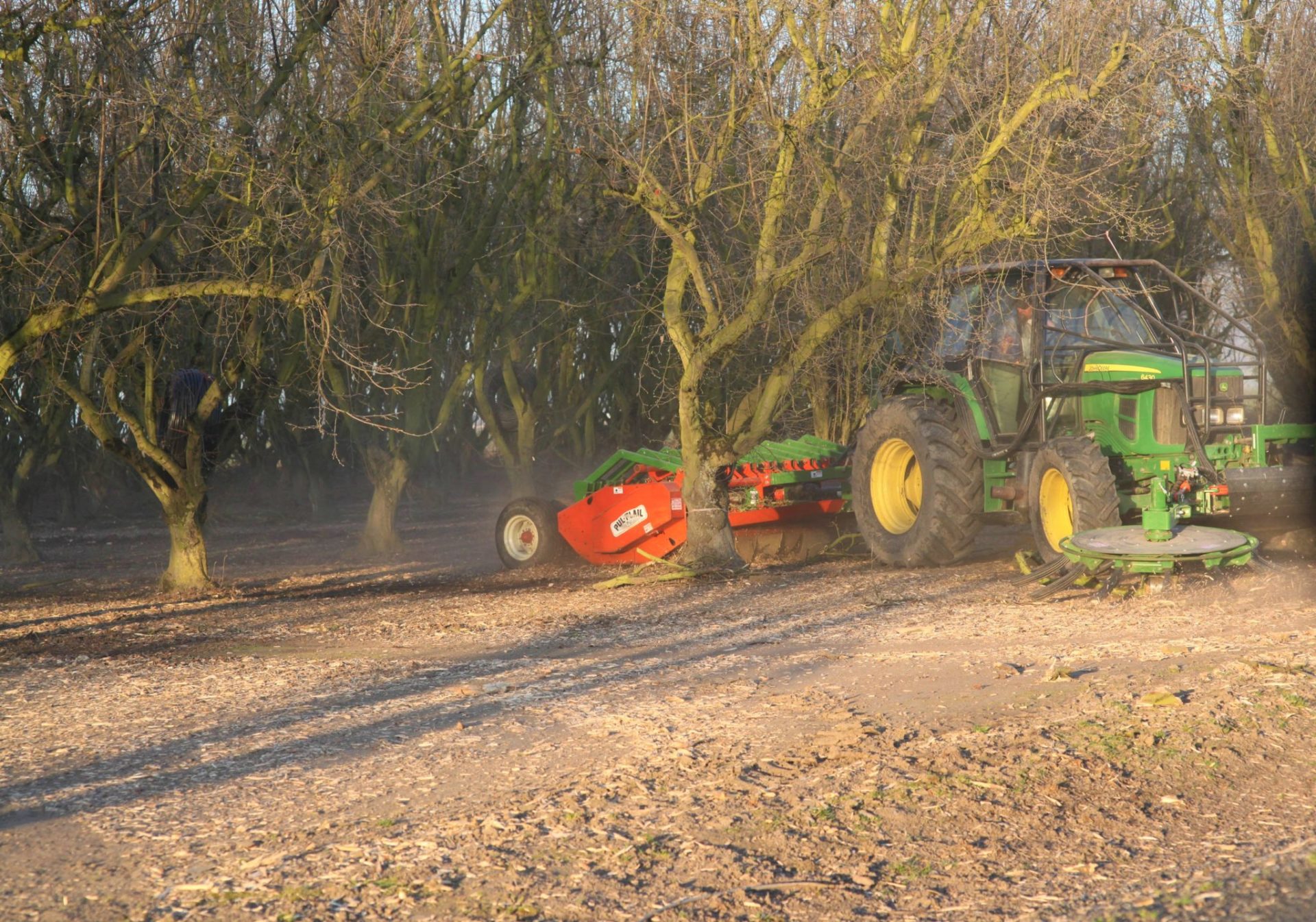
Proper training of young hazelnuts helps build a solid support structure that can stand up to ice, snow and heavy nut crops. Training young hazelnut trees are done in the first four or five winters. Continued pruning of older trees maintains a solid framework, increases production and encourages vigorous new growth.
Training Trees
There are two types of pruning cuts for hazelnuts: thinning cuts and heading cuts. Thinning cuts remove an entire branch. Heading removes only part of a branch. According to Oregon State University (OSU) researchers, after planting trees, it’s best to top the tree with a heading cut 28 to 34 inches from the ground. Since transplanting is hard on the root system, topping the new trees helps reduce their water needs. Topping will also encourage new growth below the cut. The trees will grow many new leaders, and grow larger more quickly.
During the first winter, carefully consider which three to five limbs will become scaffold limbs. Scaffolds will form the tree’s framework. Look at the crotch angle between the trunk and limb when choosing scaffolds. A 45- to 60-degree angle makes the strongest limb.
Remove suckers growing from the ground as often as necessary. Cut out suckers (or carefully spray) when they are still young and green. Suckers are tougher to get rid of once they harden off.
During the second winter, choose one or two additional scaffold limbs. Look for limbs that are spaced evenly around the trunk and have approximately 6 inches of vertical space between them. Prune out the rest of the branches. If the primary scaffold branches have put on a couple of feet of new growth, but haven’t sent out lateral shoots, make a heading cut on those branches to encourage shoot formation. The leader is the highest point of a scaffold limb. Train central-leader trees with one leader, or train trees as multiple leaders, which generally have three, four or five leaders.
General Pruning Tips
Pruning Young Trees
- Don’t use heavy pruning on young trees. According to OSU researchers, that is a common mistake made by new hazelnut growers.
- Continue to remove branches to keep center of tree open. Besides letting in more light, which helps tree produce more nuts, this will also allow for better spray coverage.
- Prune to develop a strong and balanced branch framework.
- Remove poorly positioned branches—ones that rub together, cross or are positioned too low.
- Remove unwanted branches when they’re small. Small pruning wounds heal faster than large wounds.
- Continue removing suckers.
Pruning Mature Trees
- Most pruning on older or maturing trees is done with thinning cuts.
- Growers can use a heavier pruning hand on mature trees, especially if the trees showed poor growth the previous year. Pruning stimulates new growth.
- For best production, hazelnut trees should put on at least 6 to 8 inches of new growth every year. Measure the growth of branches that are at shoulder height.
- Remove low-hanging branches.
- Prune out dead or diseased wood.
- Remove sucker and water sprouts.
Prune in winter, spring or summer months. Pruning during the dormant season from December to February will produce vigorous growth the next spring. Use summer pruning to remove suckers and dead or dying limbs. Leave bottom branches longer so tree forms a triangle shape.
If trees have been neglected, it’s best not to try and catch up on all the pruning at once. Oregon State Extension recommends that growers remove no more than 25 to 30 percent of live canopy in any single year. Regular pruning may help some hazelnut varieties to produce more evenly from year to year, instead of a heavy crop one year, and light the next. Since nuts set on 1-year-old wood, instead of pruning an entire mature production orchard in one winter, Extension recommends pruning one-fifth of the orchard each year.
Wounds on hazelnut wood are especially susceptible to fungi and rot. It’s important to prune at the branch collar—the raised area at the base of a branch. It’s hard to see the branch collar on hazelnuts, but it’s important not to prune flush with the trunk. It’s equally important not to leave a stub, which won’t properly heal. The branch collar contains special cells that seal off wounds.
Don’t paint or spray wounds.

Sacrificing Early Yields for Long-Term Gain
Hazelnut grower Ryan Glaser of Mid-Willamette Farms in Tangent, Oregon has a unique take on pruning. He’s willing to sacrifice his earliest crops in order to grow a strong, bowl-shaped structure on his young Jefferson trees.
“I’m not so concerned about the initial yield,” Glaser said. Instead, he believes in laying the correct tree structure, knowing that higher yields are coming in the future.
“We prune hard early. I work on a solid tree and a good trunk,” he said. “I push nutrients hard.”
Glaser’s youngest orchard is planted in blocks. He has 56 acres of 4-year-old trees, 40 acres of 5-year-old trees, 40 acres of 6-year-old trees, 40 acres of 7-year-old trees and 80 acres of 9-year-old trees. All are Jefferson.
“I really like this tree. For me, it has a great structure,” Glaser said.
Jefferson is the first Eastern filbert blight (EFB) resistant release from OSU. It was released in 2009.
When training young trees, Glaser makes sure to get good branch spacing and correct notch angles.
“I prune them hard the first four years. I think it pays dividends in the end. I topped my four year olds at four and a half to five feet.” Glaser said, noting that he realized his yield will initially be poor.
Next year he’ll just do some clean-up pruning to keep the trees’ bowl shape. One year, Glaser waited for his pruning advisor until March. His young trees grew top heavy without enough root structure.
“I grew too good of a tree,” Glaser said.
He topped those trees hard to get a solid root structure and a good trunk caliper. Hazelnut trees tend to get loose in the ground in wet and windy areas, like Glaser’s orchard. His pruning program helps counterbalance that problem.
The data’s not all in, but Glaser says his trees are out-yielding trees in different pruning and nutrient programs by a couple of percentage points.
“It’s a lot of work,” Glaser said about his aggressive pruning, “but I think I’ll have a better tree in 40 years.”
Glaser’s dad, Dennis Glaser, planted Barcelona trees in the early 1980s. It’s one of the varieties hardest hit by EFB. The Glasers continue to prune out diseased branches on their mature Barcelonas.
“Growers who are trying to fight Eastern Filbert Blight are pruning heavily and basically growing new trees,” said Pacific Northwest hazelnut grower Telly Wirth.
Three years ago, the Glasers heavily pruned on their mature Barcelonas and had nice new growth coming along. This year, they noticed the blight had come back and hit that new-growth wood. Eventually they plan to replace their 110 or so acres of Barcelonas with Jefferson with 15 to 20 acres retiled and replanted soon to replace trees that were flooded.
“Maybe put in some Polly O’s,” Ryan Glaser said.










